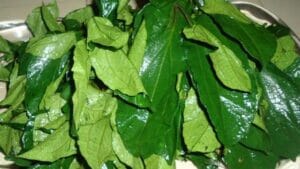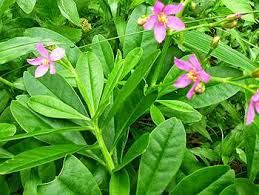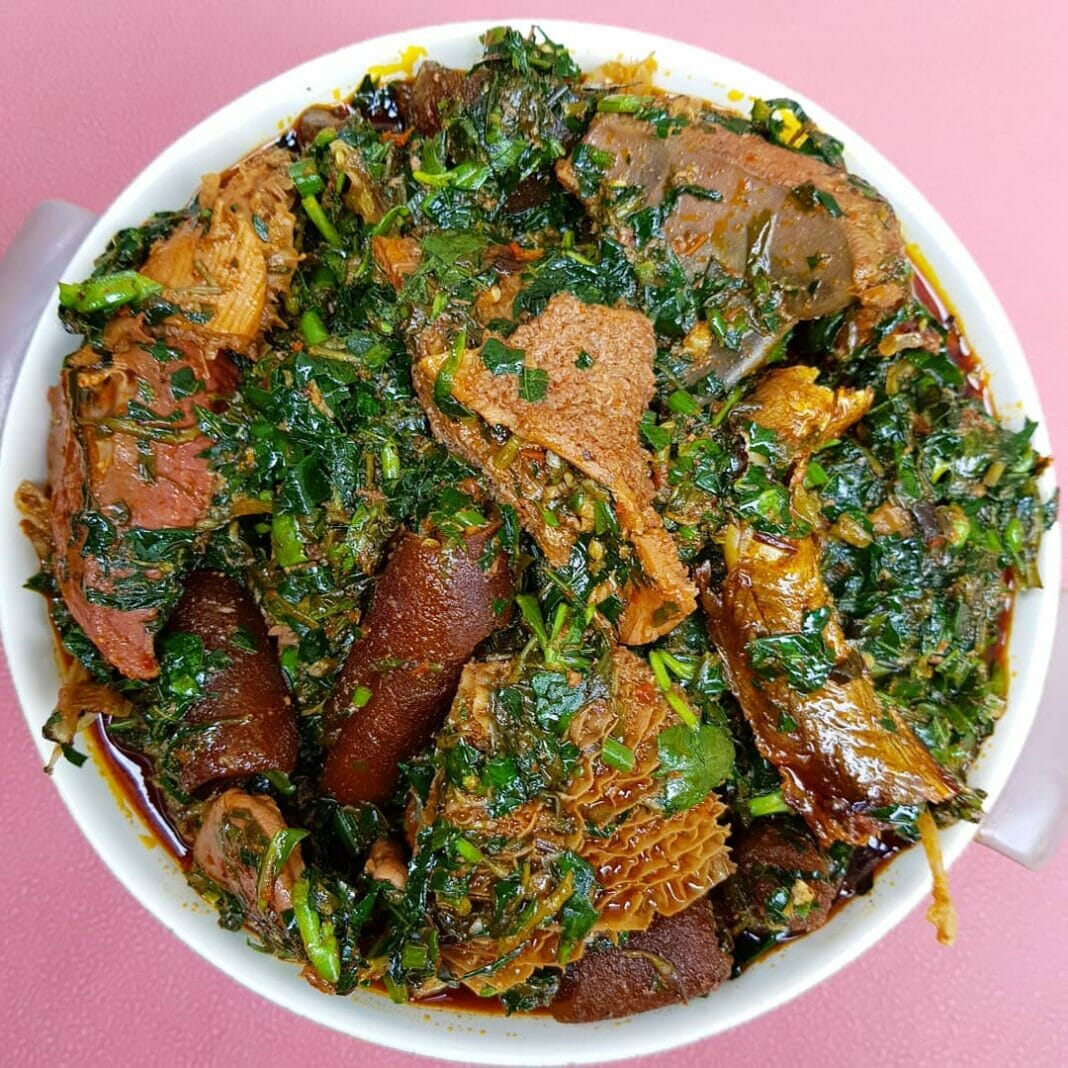Edikaikong soup is a soup native to the Efik people of Cross River State and Akwa Ibom State people in Southeastern Nigeria.
It is made with fluted pumpkin leaves (traditionally referred to as Ugwu leaf) and Ceylon spinach (usually referred to as water leaf).
It is a vegetable soup that shares a striking resemblance with Afang soup. Afang soup is another vegetable soup native to the Efik people of Cross River State and Akwa Ibom State in Southeastern Nigeria.
The only difference between edikaikong soup and afang soup is that edikaikong soup is made from water leaf and ugwu leaf, while afang soup is made from water leaf and afang leaf. However, both soups are prepared the same way.
Edikaikong soup, otherwise known as edikang ikong soup, is a highly nutritious and delicious soup.
The soup is an expensive soup to prepare. A traditionally prepared edikaikong soup is rich in seafood and various types of meat.
The high preparation cost of edikaikong soup is the reason why it is mainly eaten on special occasions. Interestingly, mosts believe that only the rich can afford to eat this dish when there is no celebration.
As is always the case, there is more to a meal than its delicious taste. In this article, we’ll discuss:
-The nutritional benefit of fluted pumpkin leaves (traditionally referred to as Ugwu leaf);
-The nutritional benefits of Ceylon spinach (traditionally referred to as water leaf) and;
-How to cook Sweet Edikaikong Soup
Without wasting time, let’s discuss the nutritional benefits of Ugwu leaf.
10 Nutritional Benefits of Ugwu Leaf

Ugwu is an edible green leaf that grows primarily in West Africa. Ugwu can be boiled and eaten alone or added to different dishes for its rich taste. Ugwu leave is one of the core components of edikaikong soup.
Apart from adding flavour to food, it is also highly nutritious. It is rich in vitamins and micronutrients.
Here are10 the nutritional benefits of ugwu:
Rich Source of Dietary Fiber
As with many leaves, ugwu is rich in dietary fibre. Dietary fibre helps the body digest food.
Dietary fibres help to maintain the movement of the gastrointestinal tract and its general health. They, nutritional fibres, prevent constipation and tummy upsets.
Weight Management
Dietary fibres help with weight loss management. They keep one full and have a lower appetite. Ugwu contains no calories, so the body has no build-up of calories. Conversely, a build-up of calories in the body contributes to weight gain.
Helps in the Repair of Torn Tissues and Muscles
Ugwu is rich in proteins and vitamins. The vitamin C content of Ugwu helps to prevent blood clotting and encourages wound healing. Protein helps in the repair of body tissue and torn muscles. In addition, Ugwu improves general skin health.
Rich Source of Antioxidants
Plants are generally rich in antioxidants, and ugwu is not an exception. In addition, Ugwu is rich in flavonoids, alkaloids, hydrocyanic acid, tannins, and resins.
Together, these antioxidants prevalent oxidative stress and inflammation in the body. Antioxidants also help to prevent cancer by interacting with the free radicals that can cause body damage.
If free radicals are allowed to travel the body freely, they’ll interact with biological cells. This interaction can lead to mutation in DNA, which will result in cancer formation.
Used to Treat Convulsion
Traditionally, ugwu is used in treating convulsion in children. Unfortunately, there are no scientific studies to prove this fact. However, in the rural communities, ugwu is believed to stop convulsion.
Prevents Hormonal Imbalance
The protein content of ugwu prevents hormonal imbalance. Protein helps to stabilize the body’s pH level. The body’s hormones will be affected if the pH is too high or low.
Blood Sugar Regularization
Ugwu has anti-diabetic properties, which can reduce blood sugar. However, how Ugwu achieves this feat is still unclear.
However, studies have shown that ugwu extracts improve the level of serum insulin. Therefore, Ugwu extract is drunk conventionally to reduce blood glucose levels.
Prevents Anemia
A person is said to suffer from anaemia when they don’t have enough red blood cells to circulate oxygen around the body. This means red blood cells are deficient or in short supply.
Iron is a crucial mineral needed for red blood cell production. Red blood cells need iron to be produced.
An external supply can suffice if the body’s supply of iron is exhausted or inefficient for producing red blood cells.
Ugwu is a rich source of iron. So it supplies the body with external iron and promotes the production of red blood cells. This, in return, prevents the occurrence of anaemia.
Ugwu is usually boiled, then pounded, and the juice extracted. Anaemic patients drink this iron-rich ugwu juice.
Maintenance of the Skeletal System
Potassium, magnesium, and calcium are minerals that maintain the skeletal system. These three minerals are in abundance in ugwu.
Magnesium and calcium work together to ensure healthy bones and teeth. Potassium and calcium also work together to maintain bone density. In addition, these minerals help to prevent osteoporosis in old age.
Improves Fertility
Ugwu leaf has been used traditionally as a treatment for infertility. This practice has been used for years to treat both men and women for infertility.
The mechanism behind this action is vague, but it is believed that the rich nutritional content of the leaf plays a significant role.
Most people believe that ugwu contributes to the health of testicles and improves sperm count in men. It is also given to new mothers to help increase breast milk production.
Now that we’ve discussed some nutritional benefits of ugwu, let’s talk about water leaf;
4 Nutritional Benefits of Waterleaf

Waterleaf is a plant that goes by many names. Some of its ‘many’ names include:
-Cariru
-Florida spinach
-Ceylon spinach
-Surinam Purslane
Its growth in many countries is the reason why it has many names. However, one thing everyone can agree on is that it is green and nutritious.
Here are 4 Nutritional benefits of eating waterleaf:
Maintenance of the Skeletal System
Just like ugwu, waterleaf also contributes to general bone health. Waterleaf is rich in calcium and phosphorus; These minerals work together to maintain the skeletal system. Calcium and phosphorus also prevent osteoporosis in old age.
Maintain Eye Health
Waterleaf is rich in vitamin A which is suitable for the eye. Studies have shown that vitamin A helps to reduce the probability of eye disease and improves vision.
Prevents Anemia
Waterleaf prevents iron deficiency and anaemia by supplying the body with external iron. The iron content in iron works the same way as that in ugwu (explained above).
Prevents Cognitive Disorders
It is believed that vitamin C prevents age-related cognitive disorders like Alzheimer’s disease and others. Interestingly, waterleaf is a rich source of vitamin C
So far, we’ve looked at the nutritional benefits of the main leaves used in the preparation of edikaikong soup. Now, let’s discuss the mood of preparation.
How to cook Sweet Edikaikong Soup
Ingredients
-Washed and sliced waterleaf
-Washed and chopped ugwu leaf
-Goat meat or cow meat
-Snails
-Smoked Shrimp
-Smoked fish
-Palm oil
-Scotch bonnet peppers
-Grounded crayfish
–Periwinkle
-Seasoning cubes
-Salt to taste
Steps of Preparation
1. In different pots, season the preferred meat and snail to taste.
2. Steam the seasoned meat and snails with very little water.
3. When the meats are tender, remove them from the heat.
4. Transfer the sliced waterleaf into a pot and steam it on low heat.
5. After 2 minutes, add the seasoned meat and its stock to the pot
6. After 2 minutes, add the shrimp, smoked fish, and snail.
7. After a minute, add the powdered crayfish and periwinkle to the pot.
8. Add the seasoning cubes to taste and stir the pot.
9. Add the sliced ugwu leaf and salt to taste.
10. Add palm oil to the mixture (make sure it isn’t too much).
11. Stir the pot of soup and cook for 1 minute, then turn off the heat.
12. Your soup is ready. You can serve with any complement of choice.
Conclusion
Edikaikong soup is a vegetable soup. It is native to both the Efik people of Cross Rivers state and Akwa Ibom state people.
Edikaikong soup resembles afang soup. Both soups are made the same way. The only difference between the soups is the leaves used.
There is more to edikaikong soup than its delicious taste. The soup is highly nutritional and provides you with a variety of health benefits.
The soup is made primarily from two leaves: ugwu leaf and waterleaf. Independently, these leaves are highly nutritional. In addition, studies have shown that these leaves have medicinal properties.
Ugwu leaf is believed to:
-Have anti-diabetic properties;
-Maintain the bones and teeth;
-Prevent anaemia;
-Manage weight loss;
-Prevent indigestion;
-Repair torn tissues and muscles;
-Used to treat convulsion in children;
-Prevent hormonal imbalance;
-Improve fertility in both men and women;
-Prevent the formation of cancer cells.
Waterleaf is believed to:
-Improve the eye vision and promote overall health;
-Prevent age-related cognitive disorders;
-Increase the production of blood cells;
-Maintain the skeletal system.
If these leaves are nutritious independently, imagine how rich edikaikong soup is. Also, it is important to note that the richer the ingredients in the soup, the sweeter the soup will turn out.




My favorite
In akwa ibom they call it afere nkong ubong🙄🙄
The Efiks has the Edikang ikong 😁
Flourishing Mercy Ikpeme who ask you the difference?
Abigail Jay Thomas common dai it, why taking it so personal, do I look like your mate?
Flourishing Mercy Ikpeme big madam sorry my senior sister no vex
Abigail Jay Thomas you’re welcome my darling, was only catching cruise with my comment nothing serious
🙄😜🐿️😂🤣😂🤣😆😛😝😀🤸🤸🚶🚶🚶una Weldon oh
Bring it this side please
That is it
So Delicious
U lie
Pls do well to use it with fofo
🍧🍨
Your recipe was not complete
Pictures of the ingredients used
Wow delicious soup I love this soup so much 😋🍲
Nice food
Good Soup, i can smile it
you people will not kill me oo here ooo
My favorite soup with Afang soup
I wil eat oooo